Mandrels
Precision Mandrels, Wires and Tube Components for Medical Devices

A mandrel is defined as a spindle for supporting a workpiece whilst it is being machined or assembled. Therefore a strong, supportive material is usually required in order to maintain the rigidity of the workpiece. Another important requirement of a mandrel is that it can be released from the final workpiece without damaging it.
Mandrels are an important part of our product range for the catheter delivery system market. Our other related products are pull-rings, pull-wires, continuous wire coils, wire-forms and specialty laser welded assemblies.
We also manufacture precision ground core wire stylets. Materials most commonly used are stainless steel, nitinol and tungsten.
Materials
The majority of our mandrels are made from either austenitic stainless steel or from nitinol. The primary grades of stainless steel used are AISI 304, AISI 304V, AISI 302 and AISI 316. Where straightness and rigidity are required, high tensile or spring hard stainless steel is used. For flexibility, superelastic nitinol is the material of choice. Special applications, such as enhanced radiopacity, call for other mandrel materials; tungsten, platinum and titanium can be used as mandrels in these special applications.
Materials that do not require high-temperature oven processing can often utilize polymer mandrels, usually made from acetals. The use of polymer mandrels has proliferated in recent years due to the increase in catheter innovations and demand for thin-walled, tight tolerance designs. Catheters that use polyimide or PTFE layers often require oven curing at temperatures exceeding melt temperatures of polymer mandrels, and therefore require metal mandrels.

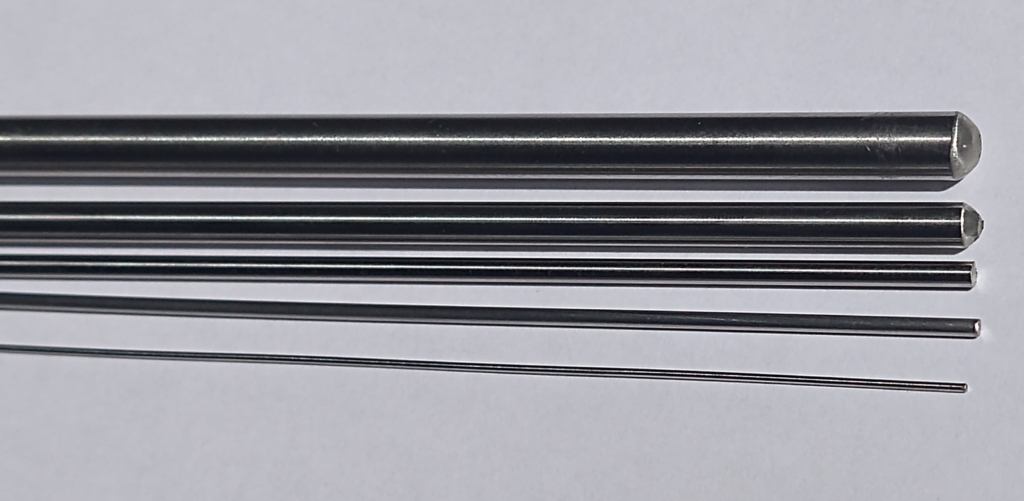
Coatings
We offer PTFE coated mandrels and mandrels coated with parylene. Both coatings are used to increase the lubricity, i.e. reduce the friction between the supported catheter delivery system and the mandrel. Whilst PTFE has a lower coefficient of friction than parylene, and is a harder coating, parylene is preferred for specific applications. In high friction applications, parylene will wear faster than PTFE. However in low friction applications, Parylene has better wear characteristics.
PTFE coating thickness is generally between 0.02mm and 0.05mm. For Parylene, 0.1 to 5 micron thicknesses can be achieved. A balance needs to be struck here between the desire for a thin coating and for a fully lubricious, pinhole-free but thicker coating. PTFE coatings are generally more economic and have the additional advantage of being available in a variety of colours.
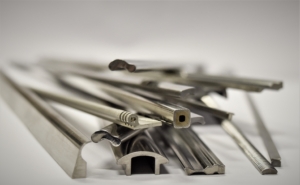
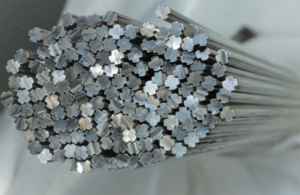
Mandrels-forms and shapes – wire and rod
The standard requirement is for straight mandrels, between 100mm and 3000mm (between 4” and 10ft) long, with diameter ranging from 0.3mm (0.012” diameter) to 10mm (0.4” diameter). Mandrels will, as a standard, have deburred, chamfered or rounded ends depending on customer preference.
We centreless grind straight mandrels to a tolerance of +/- 0.002mm (+/-2/10000” tolerance).
On request, we can supply mandrels centreless ground to more than one diameter along the length i.e. tapered mandrel, stepped mandrel, D-shape mandrel. Machined end-forms to each mandrel are possible, as are grooved mandrels. Crescent shaped mandrels, half-moon shaped mandrels and star-shape or profiled mandrels are drawn incorporating channels or “grooves” along their length. Some examples of these different shapes and forms are shown below.
Finally, we manufacture mandrels which are wire-formed. Starting with straight, centreless ground bar or wire, we wire-form each individual mandrel to customer specification. Shipping mandrels, for their easy removal, have a small loop at one end as shown. Bent, or wire formed mandrels might be specified in order for our customer to manufacture a similarly shaped delivery system by cladding the mandrel then setting the final polymer shape. Our laser welding capability enables burr removal and joining mandrel “legs” together in order to consolidate the precise mandrel shape.
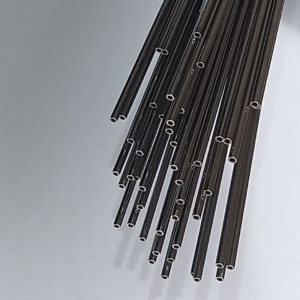
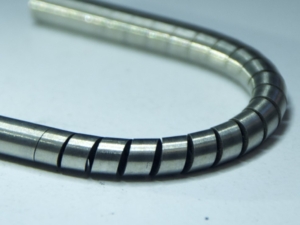
Mandrels-forms and shapes – hypotube
Stainless steel hypotube and nitinol tube are used to manufacture mandrels which require passage of a fluid or gas through them. This is sometimes the case when part of a flexible polymer delivery system, such as a balloon, is being manufactured by coating the mandrel then inflating the polymer. Inflation often occurs through laser-drilled holes drilled in the stainless steel hypotube. Laser cut hypotube is also used as a “flexing” mandrel, whereby the hypotube flexes its shape before or during polymer overlay.
Mandrels – customer applications
The majority of our mandrels are used to support catheter delivery systems while they’re built into finished products by our customers. This involves cladding each mandrel with the stack of materials used to build the catheter system, often beginning with a polymer such as Pebax®, a block copolymer variation of PEBA (polyether block amide).The main benefits of Pebax® materials include flexibility, good elasticity, high impact resistance, energy return and fatigue resistance. Further layers are then built up according to the properties required; wire braid reinforcement or wire coil reinforcement can be used to rigidize the catheter. Laser cut hypotube can also be used for this purpose.
Catheter delivery systems are used to guide catheters, stents and other therapeutic components into their correct location. Steerable catheter delivery systems are useful for guiding an implantable device through tortuous anatomical paths. Alternatively, sensors for mapping or ultrasound imaging are guided in this way. Typical surgical procedures using complex catheter delivery systems include mitral valve repair, delivering radiation to a specific anatomical site, flow diversion for brain aneurysms, and other stent delivery procedures.
Mandrels are used for coiling wires including flat wires. The use of mandrels allows coils to be wound with varying ODs and IDs along the length of the same part.
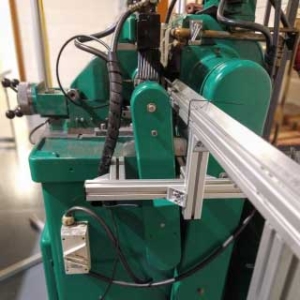
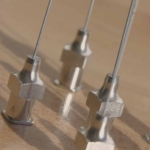
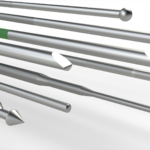
Manufacture
Key manufacturing processes are firstly wire straightening through our rotary straightening machine, then cutting to length. CNC centreless grinding and plunge grinding, provide highly consistent, clean, ground surfaces with tightly controlled diameters. Taper grinds, step grinds, D-shape mandrels or CNC sliding-head machined mandrels are produced when required. In addition to ground finish, we can also manufacture “as drawn” and “mirror polished” finishes. Straightness is controlled to ASTM F2819.
Our laser welding capability enables us to join components together to make multi-component mandrels. Tullamed’s hypodermic tubes and larger diameter tubes are used to make mandrels when heat exchange considerations require them. We offer mandrels coated in lubricious PTFE or parylene to enable easy removal of catheters. As a base material, nitinol provides additional flexibility for mandrels which are required to retain elasticity during use. For nitinol, centreless ground, as drawn, etched, oxide finish, or pickled finish are available.
Shape-profile and tubular mandrels made from stainless steel, titanium or other metals and alloys. Shaped mandrels are rolled, drawn or machined to size depending on their precise shape. When shaped micro-sized inside diameter lumens are required to be held for welding or further assembly, our mandrels elegantly perform that rigorous task.
We manufacture “grooved” mandrels, which incorporate a narrow channel for either a part or for the complete length of the mandrel. This can house a lumen and the groove is used to accurately retain it in position.
Mandrel facts and figures:
Diameters from 0.004” to 0.600” diameter
Lengths up to 3 metres
Surface (stainless steel) – centreless ground, drawn finish, mirror finish
Surface (nitinol) – as drawn, etched, oxide finish, pickled finish
Straightness manufactured to ASTM F2819
Coating PTFE, parylene
Materials stainless steel grades 304, 304V, nitinol, titanium, copper, brass
